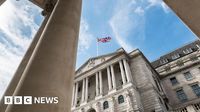The Bank of England has announced it will maintain its interest rates at 4.5% as expected, continuing to navigate the tricky balance between controlling inflation and encouraging economic growth.
This decision maintains the base rate which was cut from 4.75% to 4.5% in February 2025. The rate was previously at a peak of 5.25% last year, prompting doubts among borrowers and savers alike. Lower interest rates typically stimulate consumer spending by making borrowing cheaper, yet the Bank has expressed concerns about fostering inflation by hastening cuts.
Presently, the Inflation rate sits at 3%—above the Bank’s target of 2%. The Bank forecasts inflation will peak at around 3.7% from July to September 2025 due to rising energy prices, increased water bills, and higher bus fares. However, the Bank expects inflation to gradually return towards its target by the end of 2027.
Interest rates exert a significant influence over borrowing costs for households and businesses, as well as the returns offered to savers. For instance, a borrower taking a loan of £100 at a 5% interest rate would repay £105 in total, whereas a saver holding £100 at 5% would see their savings grow to £105. Thus, the current monetary policy is particularly crucial for those with variable rate mortgages, which are likely to become increasingly expensive if the base rate rises.
Louise Gibson, a 46-year-old resident of Epsom, Surrey, shared her perspective: "I’m petrified about what the next five years will look like and I have no idea about how I am going to find hundreds of pounds extra to pay for my mortgage." With her current fixed-rate mortgage of 1.52% ending in October 2025, she is anxious about potentially facing increased financial strain.
On the business front, the implications of these stagnated rates are significant. Kris Grumbrell, CEO of the brew-pub chain Brewhouse Kitchen, expressed hope for further cuts in interest rates: "We need something to help us mitigate some higher costs we’re seeing. I would encourage the Bank of England to think about what's happening within the economy and the cost pressures that we're facing right now."
As the Bank of England's decision highlights an uncertain economic era, it also coincides with upcoming governmental fiscal measures. Chancellor Rachel Reeves is set to make her Spring Statement next week, outlining how much government departments will have to spend in anticipation of rising living costs.
Looking ahead, the forecasted adjustments prompt warnings of increased household expenses, including hikes to various bills from water to broadband in early April. These changes come alongside anticipated increases in minimum wages and adjustments to state pensions and benefits, which can provide some relief to strained budgets.
The Bank of England's Monetary Policy Committee, currently composed of five women and four men, is closely watched by market analysts, with decisions impacting various facets of the economy, from mortgage rates to business investment. Having met eight times per year, their priority remains using interest rates to align inflation with the government target.
Stubborn inflation levels, coupled with dipping growth forecasts, have kept rates steady. In light of this complex economic backdrop, the MPC has expressed cautious optimism for gradual rate reductions in the future.
Interestingly, the swaps market is currently pricing in approximately 56 basis points of easing from the Bank by the end of 2025, reflecting a broader expectation for economic conditions to improve, despite the current climate.
The Bank’s latest position stems from rising inflation measurements, which rose unexpectedly to 3% in January from a December figure of 2.5%. Core inflation has also increased, now at 3.7%. Conversely, GDP figures revealed an unexpected contraction of 0.1% in January 2025, contributing to the cautious stance by the MPC aiming to ensure long-term stability within the economy.
Despite the elevated inflation, there remains hesitation toward rate cuts due to a complicated economic picture fed by global uncertainties, such as US trade policies and tariffs. The government will be eager to navigate its financial obligations carefully, especially with rising costs for public services set to inflict more pain on households.
Therefore, moving forward, the focus of both the public and the government lays in understanding how the Bank's interest rate strategy will interact with the evolving economic landscape. Meanwhile, households and businesses alike are awaiting more clarity on future financial conditions as monthly payments on loans and credit cards continue to pose challenges amid fluctuating inflation rates.
In summary, the Bank of England's recent decision to hold rates at 4.5% reflects its commitment to containing inflation while cautiously monitoring the economy's health. With significant macroeconomic occurrences looming in the near future, the interplay between government fiscal action and the Bank of England's policy banks will be paramount in shaping the financial realities of those in the UK.







